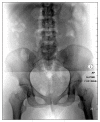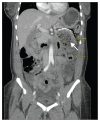The lost sponge: patient safety in the operating room
- PMID: 22761480
- PMCID: PMC3414600
- DOI: 10.1503/cmaj.110900
The lost sponge: patient safety in the operating room
Figures


Similar articles
-
Prevention of retained surgical items.Mt Sinai J Med. 2011 Nov-Dec;78(6):865-71. doi: 10.1002/msj.20299. Mt Sinai J Med. 2011. PMID: 22069210 Review.
-
Radio-frequency surgical sponge detection: a new way to lower the odds of leaving sponges (and similar items) in patients.Health Devices. 2008 Jul;37(7):193-202. Health Devices. 2008. PMID: 18771206
-
Radio frequency identification (RFID) applied to surgical sponges.Surg Endosc. 2007 Jul;21(7):1235-7. doi: 10.1007/s00464-007-9308-7. Epub 2007 May 5. Surg Endosc. 2007. PMID: 17484000
-
Gossypiboma--"a surgeon's legacy": report of a case and review of the literature.Dis Colon Rectum. 2002 Jan;45(1):119-20. doi: 10.1007/s10350-004-6124-1. Dis Colon Rectum. 2002. PMID: 11786775 Review.
-
Leave no instrument (or sponge) behind.Harv Health Lett. 2003 Apr;28(6):7. Harv Health Lett. 2003. PMID: 12777235 No abstract available.
Cited by
-
Interventions for the Prevention of Retained Surgical Items: A Systematic Review.World J Surg. 2022 Feb;46(2):370-381. doi: 10.1007/s00268-021-06370-3. Epub 2021 Nov 12. World J Surg. 2022. PMID: 34773133 Free PMC article.
-
Does Virtual Reality Improve Procedural Completion and Accuracy in an Intramedullary Tibial Nail Procedure? A Randomized Control Trial.Clin Orthop Relat Res. 2020 Sep;478(9):2170-2177. doi: 10.1097/CORR.0000000000001362. Clin Orthop Relat Res. 2020. PMID: 32769533 Free PMC article. Clinical Trial.
-
Intravesical gossypiboma: our experience and the need for stringent checklist and training!BMJ Case Rep. 2019 Feb 1;12(2):e227278. doi: 10.1136/bcr-2018-227278. BMJ Case Rep. 2019. PMID: 30709885 Free PMC article.
References
-
- Leape LL, Brennan TA, Laird N, et al. The nature of adverse events in hospitalized patients. Results of the Harvard Medical Practice Study II. N Engl J Med 1991;324:377–84 - PubMed
-
- Cima RR, Kollengode A, Garnatz J, et al. Incidence and characteristics of potential and actual retained foreign object events in surgical patients. J Am Coll Surg 2008;207:80–7 - PubMed
-
- Wan W, Le T, Riskin L, et al. Improving safety in the operating room: a systemic literature review of retained surgical sponges. Curr Opin Anaesthesiol 2009;22:207–14 - PubMed
-
- Gawande AA, Studdert DM, Orav EJ, et al. Risk factors for retained instruments and sponges after surgery. N Engl J Med 2003;348: 229–35 - PubMed
-
- Gibbs VC. Patient safety practices in the operating room; correct-site surgery and nothing left behind. Surg Clin North Am 2005; 85:1307–19 - PubMed
Publication types
MeSH terms
LinkOut - more resources
Full Text Sources
Medical
